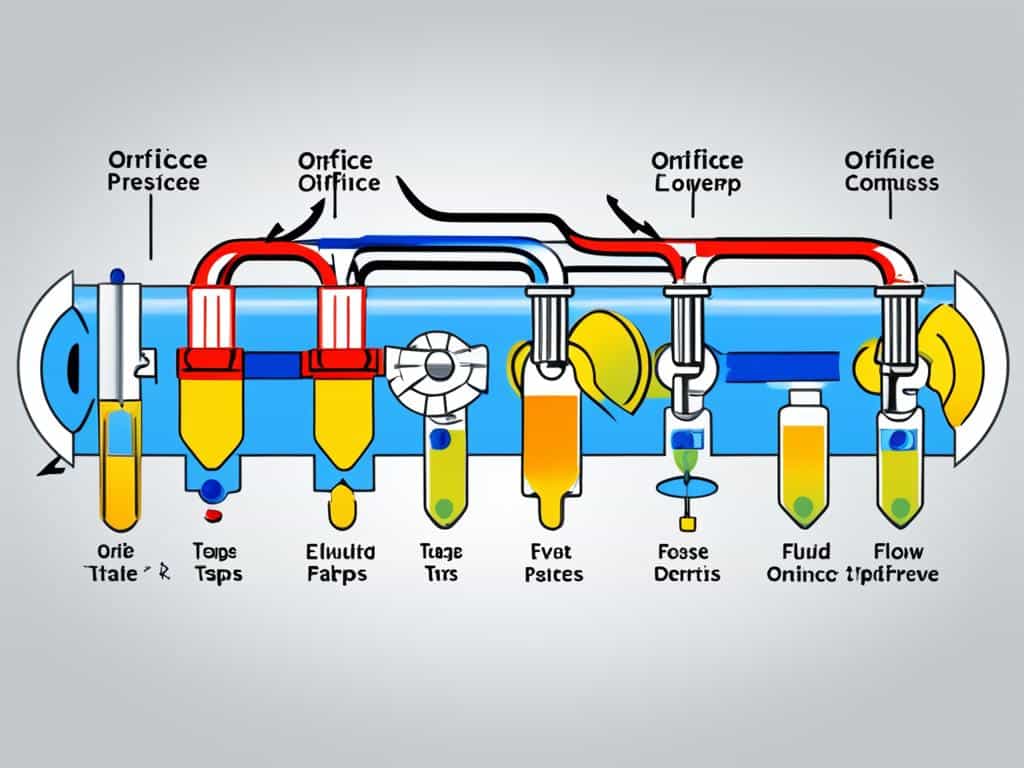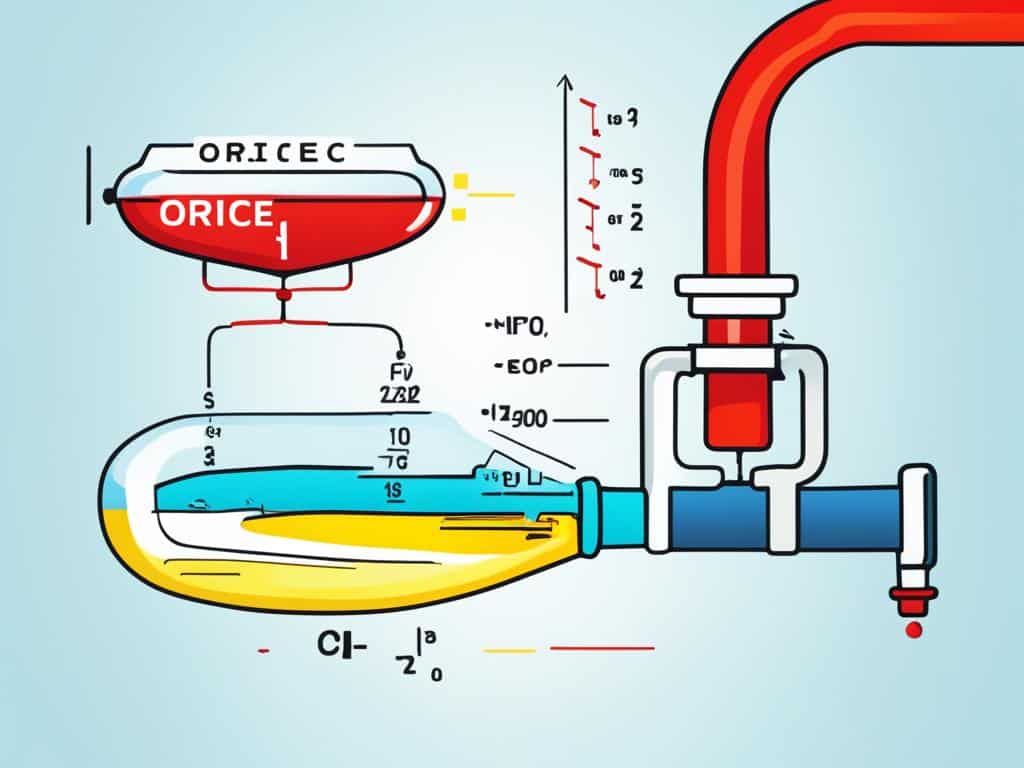Energy Equation Used in Orifice Meter: A Beginner’s Guide
The energy equation used in orifice meters, based on Bernoulli’s principle, relates the differential pressure across the orifice to the flow rate, enabling accurate fluid flow measurement.

Do you know orifice meters can measure fluid flow with almost 100% accuracy? This key idea, based on Bernoulli’s principle, is crucial for correct fluid flow measurement. It’s used in many industries such as water treatment and fuel systems.
The energy equation in orifice meters links the pressure difference over the orifice to the flow rate. It allows for precise measurement of fluid flow. Orifice flow happens when liquid or gas moves through a small opening, much smaller than the pipe. The main formula for flow in this scenario is Q = C√(2ΔP/ρ). Here, Q is flow rate, C is discharge coefficient, ΔP is pressure difference, and ρ is fluid density. The value of C changes based on orifice size, it’s fluid, and the pressure.
Fenice Energy has over 20 years of experience in clean energy, including solar and EV charging. They deeply understand fluid movement and how to manage energy. These skills help them offer great advice and support in orifice flow and fluid system design.
Key Takeaways
- The energy equation used in orifice meters is based on Bernoulli’s principle, relating the differential pressure across the orifice to the flow rate.
- The fundamental formula for orifice flow is Q = C√(2ΔP/ρ), where Q is the flow rate, C is the discharge coefficient, ΔP is the pressure difference, and ρ is the density of the fluid.
- The discharge coefficient, C, depends on the shape and size of the orifice, the type of fluid, and the overall pressure conditions.
- Orifice meters are widely used in various industries, such as water treatment, fuel injection systems, and industrial processes, to accurately measure fluid flow.
- Fenice Energy’s expertise in clean energy solutions can provide valuable insights and support in the field of orifice flow measurement and fluid system design.
Understanding Orifice Flow and the Energy Equation
Orifice flow is a key part of understanding how fluids act in a narrow opening. It is used in many areas like water measurement, hydraulics, and combustion. Essentially, orifice flow is about fluids passing through a small space.
Definition of Orifice Flow
Orifice flow means fluids moving through a tiny hole. This hole is much smaller than the path the fluid is traveling along. Scientists look at the pressure change across this small opening. By knowing certain properties of the fluid, they can figure out how fast it’s moving.
The Basic Concepts of Orifice Flow
Two main ideas guide our understanding of orifice flow. One is the continuity equation. It says the mass of fluid going in must match the mass coming out. The other is Bernoulli’s principle, which ties the energy of the fluid to its motion through the orifice.
Continuity Equation and Bernoulli’s Principle
These two principles are key for understanding orifice flow. The continuity equation makes sure mass is conserved. And Bernoulli’s principle links the energy in the fluid to how it moves through the orifice. Together, they help scientists predict and explain the behavior of fluids in such settings.

what is the energy equation used in orifice meter
The energy equation for orifice meters comes from a basic formula: Q = C√(2ΔP/ρ). Here, Q stands for flow rate, C is the discharge coefficient, ΔP is the pressure difference, and ρ is fluid density.
Breaking Down the Orifice Flow Formula
To understand this, let’s look at what each part measures. The flow rate (Q) shows how much fluid flows through in a given time. Discharge coefficient (C) handles losses related to friction and energy conversion. Pressure difference (ΔP) is the drop in pressure as the fluid goes through. Density (ρ) shows how much the fluid weighs per unit volume.
Applying the Formula in Practical Situations
This equation is key in many fields of engineering. It helps gauge fluid flows in pipes and figure out fuel needs for engines. Orifice flow calculations are also used in water systems. They help design systems that use water effectively.

Orifice Flow in Real-World Applications
Orifice flow is a key idea in fluid mechanics, seen in many real-world uses. This includes items like garden sprinklers, oil flowing from cans, and the way aerosol cans work.
Real-Life Examples of Orifice Flow
Garden sprinklers use small holes to make a water jet with high velocity. The same idea applies to oil from a can and gas from aerosol cans. Here, the pressure difference across the orifice controls how fast the liquid or gas comes out.
Orifice Flow in Engineering and Fluid Mechanics
Orifice flow matters a lot in designing and understanding systems in engineering and fluid mechanics. In hydraulic systems, for example, valves with different orifice sizes help control fluid speed. Fuel systems in cars also use orifice flow. Here, fuel passes through a small opening, atomizing the fuel for ignition. Instruments like Venturi meters and orifice meters work this way too. They use orifice flow to measure pressure drops and fluid speed.
Orifice Meter Design and Operation
An orifice meter has a thin plate with a small hole that slows down fluid. It has pressure taps before and after the plate to check pressure changes. This meter works using two main physics principles, the continuity equation and Bernoulli’s principle.
Working Principle of Orifice Meters
When fluid goes through the orifice, its area shrinks, making its speed increase. This faster flow leads to lower pressure, following Bernoulli’s equation. By measuring this pressure drop, we can find out the fluid’s speed and flow rate.
Types and Configurations of Orifice Meters
Orifice plates come in different shapes for various fluids. The most common is the concentric type. It’s good for most fluids. There are also special types for fluids with solids. The meter’s tapping points change based on pipe size, like corner taps or D and D/2 taps.
Advantages and Disadvantages of Orifice Meters
Orifice meters are easy to put in, cheap to make, and can be used with any material or size of pipe. But, they cause a big drop in pressure, don’t work well with low-pressure systems, and can only measure in a small range of 3:1 to 5:1.
Conclusion
The energy equation in orifice meters is key for fluid mechanics and engineering. It’s rooted in Bernoulli’s principle. This principle links the pressure difference over the orifice with the flow rate, allowing precise fluid flow measurement.
The orifice flow formula works in many practical uses and engineering. It shows up in things like garden sprinklers and industrial systems. This formula helps us understand how fluids move, guiding design and operation.
Orifice meters are trustworthy and cheap for measuring flow rates. They do have limits, like high pressure loss and a narrow measuring range. Yet, their easy setup and flexibility are why they’re chosen in various fields.
Grasping the energy equation used in orifice meters and orifice flow basics is crucial. It’s key for engineers and techs working on fluid systems. With Fenice Energy’s 20 years of know-how, we offer deep insight and support in this area.
FAQ
What is the energy equation used in orifice meters?
The energy equation in orifice meters uses Bernoulli’s principle. This principle links the pressure difference across the orifice with the flow rate. It allows for precise measurement of fluid flow.
The main formula is: Q = C√(2ΔP/ρ). Here, Q equals flow rate, C stands for the discharge coefficient, ΔP is the pressure difference, and ρ denotes fluid density.
What is orifice flow, and what are the basic concepts behind it?
Orifice flow describes liquid or gas moving through a small opening. This opening, the orifice, is much smaller than the pipe it flows through. Essentailly, two key concepts govern orifice flow.
First is the continuity equation. It says that as much mass that goes into the orifice must come out. Second is Bernoulli’s principle. This principle connects different types of energy in the fluid as it passes the orifice.
How is the orifice flow formula applied in practical situations?
The orifice flow formula, Q = C√(2ΔP/ρ), is useful in many fields. It helps measure fluid flow, calculate fuel flow in engines, and assess hydraulic system efficiency. For instance, in water systems, it finds the water flow through narrowed pipes. This helps in designing efficient systems.
What are some real-life examples of orifice flow?
Orifice flow is seen in many common situations. For example, it occurs when a garden sprinkler is on, or when oil flows from a can. Even in everyday items like spray cans, the orifice controls fluid flow based on pressure differences.
How do orifice meters work, and what are their advantages and disadvantages?
An orifice meter includes a plate with a hole that restricts flow. It has pressure measuring points before and after this plate. The design uses the continuity equation and Bernoulli’s principle.
Orifice meters are easy to install and make. They also don’t have material or size restrictions. Yet, they cause a significant drop in pressure. They are not suited for low-pressure systems. Also, they have a narrow measuring range of 3:1 to 5:1.


